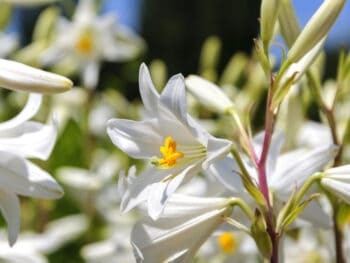Join me in a summer garden adventure by cultivating calamus. Normally, I report to you on plants from the Bible once they are established and thriving, but this time you are in on the ground floor, pun intended! I have just ordered these transplants from Companion Plants, a good source for several Biblical species. Calamus is a plain-looking water plant with hidden allure, easily dismissed it because of its simple appearance. Dig in with me to discover its mystical mention in some of the innermost places of Scripture, and let’s grow together in an encounter with God’s grace.
But continue to grow and increase in God’s grace and intimacy with our Lord and Savior, Jesus Christ. May he receive all the glory both now and until the day eternity begins. 2 Peter 3:18 TPT
Let the Lord draw you close to Him as we get to know this Biblical garden plant.
Tabernacle Testimony
Calamus ushers us into the holiness of the Lord by its inclusion on the ingredients list for the sacred anointing oil, described in the Lord’s detailed plans for the tabernacle.
Moreover, the Lord said to Moses, Take the best spices: of liquid myrrh 500 shekels, of sweet-scented cinnamon half as much, 250 shekels, of fragrant calamus 250 shekels, And of cassia 500 shekels, in terms of the sanctuary shekel, and of olive oil a hin. And you shall make of these a holy anointing oil, a perfume compounded after the art of the perfumer; it shall be a sacred anointing oil. Exodus 30:22-25 AMPC
Myrrh, cinnamon, cassia, and calamus were called upon to infuse olive oil with uncanny fragrance. Notice none of the noteworthies were native to the Sinai Desert, where the Lord appointed the Israelites to craft this place of worship. These spices would have been acquired by trade caravans criss-crossing from Egypt to the Fertile Crescent to East Asia. The mixing of these aromas implies exquisite expense and intimate investment, and they testify to the intended extravagance of the Israelites’ experience worshipping the Lord in their desert surroundings. Remember, God had just moved mightily to bring them out of Egypt for the purpose of worship:
This is what the Lord, the God of the Hebrews, says: “Let my people go, so that they may worship me.” Exodus 9:1 NIV
Yes, landscape conditions were uncomfortable and uncertain, yet the people camped every day in the Presence of the Lord. At His request, His ministers and everything they touched—the ark, the tabernacle furnishings, and utensils—were anointed in sweet aroma. Such was the caliber of their consecration, inviting an enthralling devotion to Him.
Secret Garden
Fast forward from desert to garden, to the sumptuous estate of King Solomon, created in the countryside of En Gedi. Here we find calamus once again in a nosegay of intimacy, now a descriptor of the dimensions of beauty beholden by the king for his bride:
My sweetheart, my bride, is a secret garden, a walled garden, a private spring; there the plants flourish. They grow like an orchard of pomegranate trees and bear the finest fruits. There is no lack of henna and nard, of saffron, calamus, and cinnamon, or incense of every kind. Myrrh and aloes grow there with all the most fragrant perfumes. Song of Songs 4:12-14 GNT
The king’s delight is captured in fantastic floral scent and fruitful imagery, and calamus is in the midst of it all, offering enhancing aroma. To say he was smitten with his sweetheart is certain understatement; the king’s flourish of love is made poignant in these pleasing, extravagant plants. She is his secret garden, need we say more?
Connecting with Calamus
Both of these instances, taken from the ancient pages of God’s Word, are stunning metaphors for us to imagine today. We are the priests anointed in exotic, divine aroma! We are the bride adored by King Jesus! We are a secret, spice-scented garden kept just for Him! By turning to Jesus and accepting His sacrifice on the cross on our behalf, we belong to Him and these poetic expressions become ours to embrace.

We are planting unassuming calamus to imagine the sweetness of our worship to the Lord, thereby inspiring our constant worship of Him.
I am my beloved’s and my beloved is mine Song of Songs 6:3 NIV
You must continually let my love nourish your hearts. John 15:9 TPT
We live in a desert of sorts, lacking different levels of comfort and certainty, surrounded like the Israelites by a desolate culture. Yet we move freely into God’s presence to be captivated by Him.
For this reason, they are [standing] before the throne of God; and they serve Him [in worship] day and night in His temple; and He who sits on the throne will spread His tabernacle over them and shelter and protect them [with His presence]. Revelation 7:15 AMPC
Holy Matrimony
Concurrently, calamus restates something special, along with cinnamon and myrrh: Intimacy in marriage mirrors the most holy of the Lord. These sensual plants are spoken of both places, the beauty beheld by the king for his bride and the sweet aroma infused in the priests’ anointing oil, giving us a garden glimpse of the truths spelled out in Ephesians:
For wives, this means being devoted to your husbands like you are tenderly devoted to our Lord…And to the husbands, you are to demonstrate love for your wives with the same tender devotion that Christ demonstrated to us, his bride. Ephesians 5:22, 25 TPT
These Words define the parallel structures of the relationships of husband and wife, Christ and ekklēsia-bride, while calamus offers this same hint of holy matrimony. He leaves secret meanings in the plants….I love that about Him!
But thanks be to God, who always leads us as captives in Christ’s victory parade. God uses us to spread his knowledge everywhere like a sweet-smelling perfume. 2 Corinthians 2:14 NCV

Cultivating Calamus
Calamus is categorized with the reeds; qaneh, the Hebrew word for calamus, can also be a generic reference to reeds or branches. Acorus calamus is one of several species thought to be the calamus of Scripture. Its slender, emerald green leaves grow like the blades of iris. A central ribbing gives more upright stature to the tuft of leaf-spikes than similarly formed ornamental grasses. Calamus is easily cultivated in the home garden, most garden books say, and we shall test this together for the rest of the summer. Keep watering! Or plant at pond’s edge; rhizomes should easily establish and multiply in wet, muddy ground.
Treat calamus like a calmed down papyrus plant, LOL! Because it is hardy to zone 4, it should endure in your garden as a perennial, whereas papyrus is frost tender. Calamus flowers only in the spring with a singular spadix, or fuzzy, columnar flower spike. We’ve missed the flowering, but no worries; the aroma emits from crushed leaves and dried, diced roots. Calamus is non-edible; enjoy only for its aroma and lush habit. I must confess, my transplants are not noticeably fragrant…hopefully as they grow this summer, sweet aroma will release.
Coming Soon! Calamus in the Plant Guide. In the meantime, find more gardening information about calamus in the Missouri Botanical Garden Plant Finder
Closing Prayer
O God, I love this about You, Lord: a common-looking, pond-edge plant can lead to an epic encounter of Your holy love! Thank You for hiding so much in the horticulture, so that keeping a garden is in reality a wonder-filled, spiritual adventure. We praise You that the peace, joy, and revelation of wisdom that comes over us as we work in the garden turns out to be Your Presence sheltering and communing with us. Thank you for nourishing each of us in Your love and growing us in Your grace. You know Your loving-kindness is what we need to survive the desert-culture, and You gave everything to make sure each of us would live in Your embrace forever. Thank you, Jesus. Let all our gardening help us adore You, O Lord. Amen.
Be here—the king is wild for you. Since he’s your lord, adore him. Psalm 45:11 The Message


But wait, there’s more! Dig into many more devotions and hidden meanings in horticulture in my new book, My Father is the Gardener, Illustrated beautifully by Layla Luna

Happy Anniversary to my husband and model for our book cover. 32 years of Song of Songs love! He has led me amazingly in the ways of God’s holiness.

Learn more about Solomon’s Spices in the Plant Guide, with garden to table information on Cinnamon, Saffron Crocus, and a special poem on Aloes, or Eaglewood
Photo Credits: ©Rob Lumen Captum | Dreamstime.com Sweet flag Acorus calamus, sword-shaped leaves at water’s edge ID 241797685; all other photos ©2023 Shelley S. Cramm
AMPC notes Scripture quotations taken from the Amplified® Bible, Classic Edition, Copyright © 1954, 1958, 1962, 1964, 1965, 1987 by The Lockman Foundation. Used by permission. www.Lockman.org
GNT denotes Scripture quotations from the Good News Translation® (Today’s English Version, Second Edition) Copyright © 1992 American Bible Society. All rights reserved.
The Message denotes Scripture quotations taken from THE MESSAGE, copyright © 1993, 2002, 2018 by Eugene H. Peterson. Used by permission of NavPress. All rights reserved. Represented by Tyndale House Publishers, a Division of Tyndale House Ministries.
NCV denotes Scripture quotations taken from the New Century Version®. Copyright © 2005 by Thomas Nelson. Used by permission. All rights reserved.
NIV denotes Scripture quotations taken from the Holy Bible, New International Version®, NIV®. Copyright © 1973, 1978, 1984, 2011 by Biblica, Inc.® Used by permission of Zondervan. All rights reserved worldwide. www.zondervan.com The “NIV” and “New International Version” are trademarks registered in the United States Patent and Trademark Office by Biblica, Inc.®
TPT denotes Scripture quotations taken from The Passion Translation®. Copyright © 2017, 2018, 2020 by Passion & Fire Ministries, Inc. Used by permission. All rights reserved. ThePassionTranslation.com













